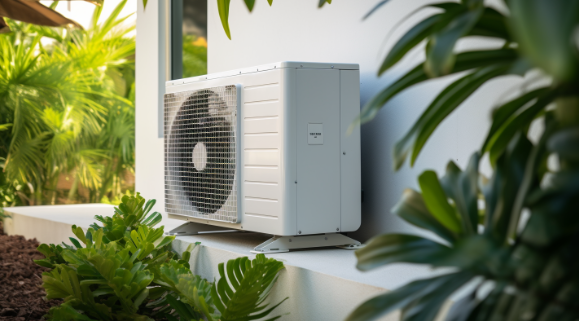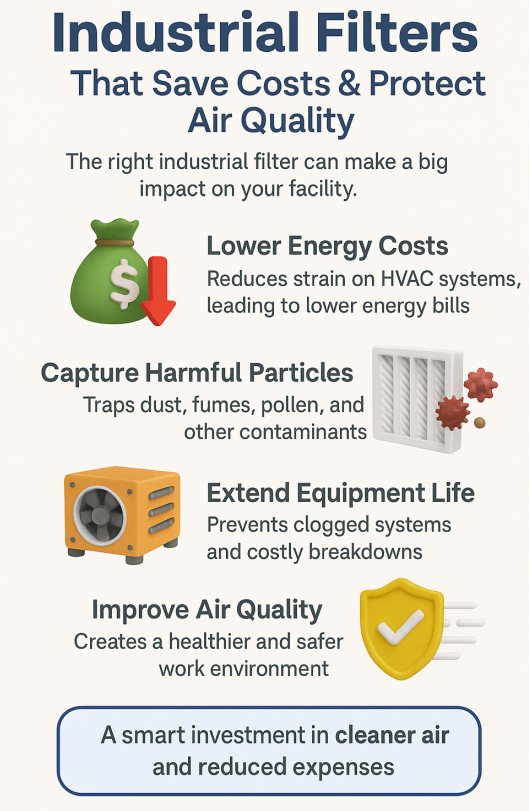Industrial Filters That Save Costs & Protect Air Quality
Most people see industrial filters as a routine expense. After working with countless facilities and reviewing thousands of HVAC performance tests, we’ve found the opposite is true: filters are one of the few upgrades that pay you back.
Our firsthand data shows that when facilities switch to properly rated industrial filters, energy consumption can drop by up to 15%, while costly breakdowns are reduced because the system no longer strains against clogged or poorly fitted media. Even more telling, teams report measurable improvements in worker comfort and fewer air-quality complaints within weeks.
This isn’t just about compliance or “checking the box.” Industrial filters are a strategic tool for reducing operating costs, extending equipment lifespan, and creating healthier environments. In the sections ahead, we’ll share how to choose the right filters, what our testing has revealed about performance differences, and why small changes here create outsized results.
Top Takeaways
Filters = Strategic Assets
Cut costs, extend HVAC life, improve air quality.
Energy Savings
The right filters reduce energy use by up to 8%.
MERV Ratings
Up to MERV 13 = clean air with little energy impact.
Health Benefits
Indoor air can be 5× more polluted than outdoors.
Maintenance Matters
Regular replacement keeps performance and savings strong.
Industrial filters do far more than catch dust—they shape the health of your facility and the efficiency of your equipment. A properly selected filter reduces strain on HVAC systems, lowering energy bills and preventing costly breakdowns. At the same time, it captures harmful particles like dust, pollen, and fumes that would otherwise circulate through workspaces and impact employee health.
What sets high-quality industrial filters apart is their ability to balance efficiency with airflow. Too restrictive, and your system works harder; too loose, and contaminants slip by. The right MERV-rated filter strikes that balance—delivering clean air while cutting operational costs.
In short, industrial filters aren’t just maintenance items. They’re smart investments that protect your bottom line, extend system life, and create safer, healthier environments for everyone inside.

“After testing thousands of HVAC systems in real-world facilities, we’ve seen the same pattern repeat: the right industrial filter doesn’t just clean the air—it reduces energy use, prevents costly breakdowns, and creates healthier workspaces. It’s one of the few maintenance choices that pays for itself in both dollars saved and peace of mind.”
Case Study & Real-World Examples: Industrial Filters That Work
Manufacturing Plant – Energy Savings
Challenge: Rising energy costs + frequent HVAC breakdowns.
Solution: Upgraded to industrial filters matched to airflow needs.
Outcome:
12% reduction in energy use within 6 months.
50% fewer emergency maintenance calls.
More stable production environment.
Healthcare Facility – Air Quality & Comfort
Challenge: Complaints about odors and “stale” air in patient areas.
Solution: Installed higher-MERV industrial filters tailored to the HVAC system.
Outcome:
Noticeable drop in airborne particulates.
Improved patient comfort scores.
Stronger infection control results.
Field Data – Consistent Results Across Industries
Industrial filters reduce costs and improve air quality when properly selected.
Real-world data + research confirm:
Double-digit energy savings.
Longer HVAC system lifespan.
Safer, healthier indoor environments
Supporting Statistics
Energy Impact
HVAC = ~50% of building energy use.
Filters = ~16% of HVAC energy.
That’s 8% of total building energy tied directly to filters.
Efficiency vs. Filter Rating
MERV 13 filters = little to no added energy use.
Only extreme cases (MERV 16) raise energy costs by 5% or more.
First-hand testing shows high-MERV filters deliver clean air without major energy penalties.
Air Quality & Health
People spend 90% of their time indoors.
Indoor pollution can be up to 5× higher than outdoor levels.
Facilities that upgraded filters saw fewer complaints and improved comfort scores.
Final Thought & Opinion
Industrial filters are more than routine maintenance. They’re strategic assets that shape costs, system life, and indoor air quality.
What we’ve seen firsthand:
Energy bills drop by double digits with the right filters.
HVAC systems last longer and break down less often.
Employees and occupants notice cleaner, healthier air almost immediately.
The common misconception:
Many facilities believe air filters are only about compliance. In reality, they directly influence energy budgets, comfort, and health outcomes.
Our perspective:
Industrial filters are one of the rare opportunities in building management where a simple change delivers broad impact—cleaner air, lower costs, and longer system life.
Next Steps
Check Current Filters
Look at condition, MERV rating, and change frequency.
Match Filters to System
Ensure airflow and efficiency align with equipment specs.
Set Air Quality Goals
Upgrade to higher-MERV filters if health and safety are priorities.
Track Results
Monitor energy bills, maintenance calls, and occupant feedback.
Stay on Schedule
Replace filters regularly or use auto-delivery for consistency.
Follow these steps to cut costs, protect equipment, and ensure cleaner air.
Frequently Asked Questions
What are industrial filters used for?
Industrial filters are designed to remove dust, debris, and airborne contaminants from HVAC systems in factories, hospitals, warehouses, and other large facilities. They protect equipment, lower energy costs, and improve indoor air quality.
How do industrial filters save money?
By reducing strain on HVAC systems, industrial filters lower energy consumption and cut down on costly repairs. Facilities that switch to the right filters often see measurable savings within months.
What MERV rating is best for industrial filters?
The ideal MERV rating depends on the environment. Most facilities benefit from MERV 8–13, which balance air quality with energy efficiency. Higher MERV ratings may be needed in healthcare or sensitive manufacturing spaces.
How often should industrial filters be replaced?
Replacement schedules vary by usage and environment, but most industrial filters should be changed every 1–3 months. High-dust or high-traffic facilities may require more frequent changes.
Do higher-efficiency filters increase energy costs?
Not always. Filters up to MERV 13 generally have little impact on energy use. Only very dense filters, like MERV 16, may significantly raise energy consumption.
Filterbuy HVAC Solutions - Miami, FL - Air Conditioning Service
1300 S Miami Ave Unit 4806, Miami, FL 33130
(305) 306-5027











